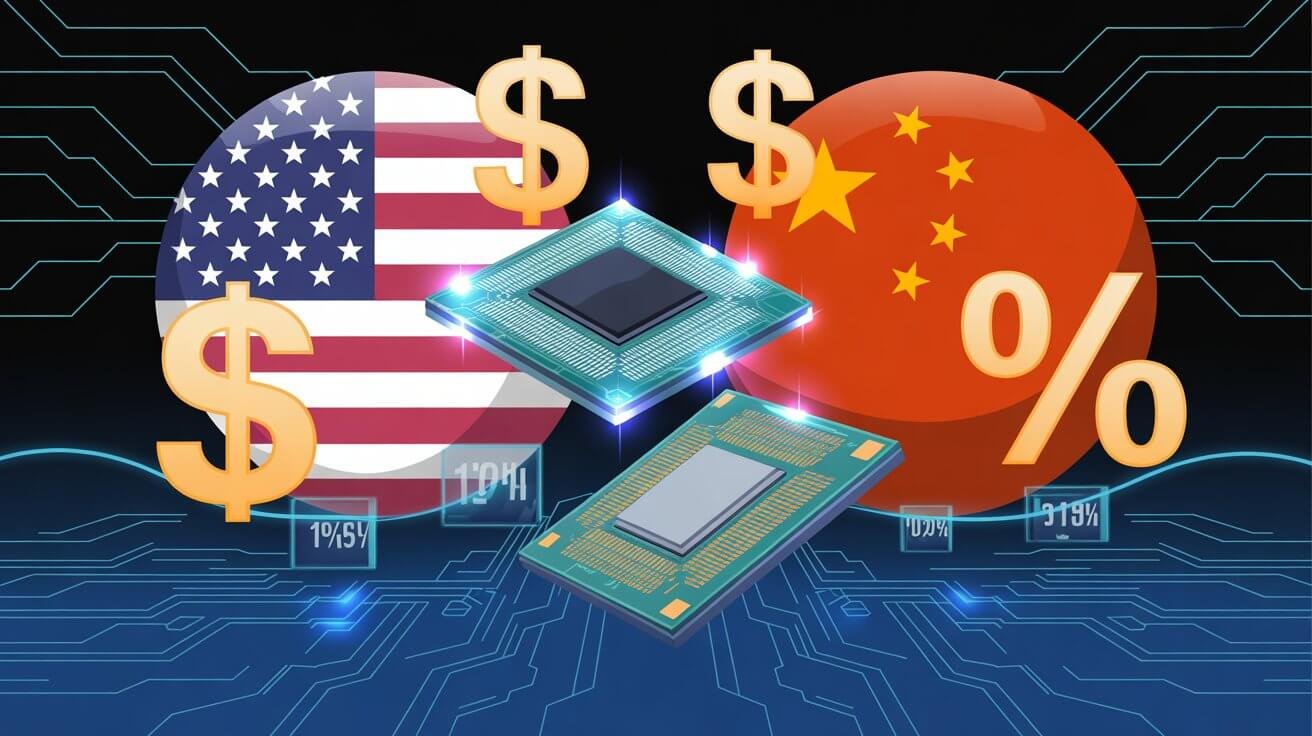The tech world is buzzing about a groundbreaking development that nobody saw coming. Nvidia and AMD have agreed to share 15% of their revenues from chip sales to China with the U.S. government, as part of a deal to secure export licenses for the semiconductors. This AI chip revenue sharing deal represents something entirely new in international trade policy, and its implications stretch far beyond the companies involved.
What makes this AI chip revenue sharing deal so significant? It’s not just about money—though we’re talking about potentially billions of dollars. This arrangement fundamentally changes how export controls work and signals a new era in U.S.-China tech competition.
The Surprising Details Behind the AI Chip Revenue Sharing Agreement
Here’s what actually happened behind closed doors. President Donald Trump confirmed at a press conference Monday that he originally wanted 20% of sales in exchange for Nvidia obtaining export licenses to sell the “obsolete” H20 chip to China, but credited Nvidia CEO Jensen Huang for negotiating him down to 15%.
This wasn’t some bureaucratic policy decision—it was a direct negotiation between Trump and Jensen Huang at the White House. After their meeting, the president called Commerce Secretary Howard Lutnick and told him to issue the licenses, according to a person familiar with the matter.
The financial stakes are massive. Nvidia earned approximately $17 billion in revenue from China in its last fiscal year, accounting for 13% of total sales. AMD reported $6.2 billion in Chinese revenue in 2024, representing 24% of its revenue. With the chip revenue sharing arrangement in place, the U.S. government could collect hundreds of millions per quarter.
But here’s the twist—the specific chips involved aren’t even cutting-edge technology. US Commerce Secretary Howard Lutnick has previously described the H20 as Nvidia’s ‘fourth-best chip’ and said it was in America’s interest for Chinese companies to use US technology, even if the most advanced products remain restricted.
Constitutional Concerns Over Export Revenue Requirements
Legal experts are raising serious red flags about this AI chip revenue sharing deal. The arrangement might actually violate the U.S. Constitution, which specifically prohibits export taxes.
“In addition to the policy problems with just charging Nvidia and AMD a 15% share of revenues to sell advanced chips in China, the U.S. Constitution flatly forbids export taxes,” Peter Harrell, the White House senior director for international economics under the Biden administration, said in a Sunday post on social media.
Christopher Padilla, a former export control official in the George W. Bush administration, went even further. He described the deal as “unprecedented and dangerous,” saying “Export controls are in place to protect national security, not raise revenue for the government. This arrangement seems like bribery or blackmail, or both”.
However, legal challenges face practical hurdles. William Aceves, a law professor at the California Western School of Law, said it would generally be up to Nvidia or AMD, who are directly affected by the arrangement, to challenge the administration in court. Companies often prefer to comply rather than fight the government, even when they have strong legal grounds.
Market Reactions to the Revenue Sharing Deal
Surprisingly, investors seem relatively unfazed by the chip revenue sharing requirement. Shares of both companies were moderately higher Monday, highlighting how investors believe the latest development is not a major negative for the companies.
The reasoning is straightforward. “From an investor perspective, it’s still a net positive, 85% of the revenue is better than zero,” Ben Barringer, global technology analyst at Quilter Cheviot, told CNBC. After months of being completely locked out of the Chinese market, paying 15% to access billions in potential revenue looks like a reasonable trade-off.
There’s also the question of pricing strategy. Companies might adjust their prices to offset the government’s cut, effectively passing some of the cost to Chinese customers. “The question will be whether Nvidia and AMD adjust their prices by 15% to account for the levy, but ultimately it’s better that they can sell into the market rather than hand the market over entirely to Huawei”.
China’s Response and Security Concerns
China isn’t taking this lying down. Over the past two weeks, Chinese authorities have raised concerns about the security of Nvidia’s chips, questioning whether they contain “backdoors” that could compromise Chinese systems.
On Sunday, Nvidia again denied that its H20 semiconductors have backdoors after accusations from a social media account affiliated with Chinese state media. The company emphasized that its H20 chip is “not a military product or for government infrastructure” and that China has “ample supply of domestic chips”.
Chinese state media has criticized the entire arrangement. China’s state-run newspaper Global Times slammed Washington’s tactics, citing an expert: “This approach means that the US government has repudiated its original security justification to pressure US chip makers to secure export licenses to China through economic leverage”.
Meanwhile, Chinese companies like Huawei continue developing their own alternatives. Morgan Stanley estimates that Chinese alternatives such as Huawei’s Ascend chips now account for 20% to 30% of domestic demand.
Broader Implications for Tech Trade and Chip Exports
This AI chip revenue sharing deal could fundamentally change how international tech trade works. Several experts worry it sets a dangerous precedent that could extend far beyond semiconductors.
“There’s no precedent for this, probably because export taxes are unconstitutional,” said Derek Scissors, China expert at the conservative American Enterprise Institute. The concern is that other countries might adopt similar revenue-sharing requirements, creating a complicated web of government taxes on international business.
Rep. Raja Krishnamoorthi expressed concerns about mixing national security with revenue generation. “Our export control regime must be based on genuine security considerations, not creative taxation schemes disguised as national security policy. Chip export controls aren’t bargaining chips, and they’re not casino chips either”.
However, some analysts see this as a pragmatic approach to a complex problem. “Semiconductor is a very unique business and the pay-to-play tactic may work for Nvidia and AMD because it’s very much about getting export approval from the U.S. gov,” The Asia Group’s Chen said.
What This Means for the Future
The chip revenue sharing arrangement raises several important questions about where U.S.-China tech relations are heading:
Will this model expand? The arrangement currently covers only specific AI chips, but it could potentially extend to other technologies or companies. Stacy Rasgon, a semiconductor analyst at Bernstein, articulated this concern: “we aren’t sure we like the precedent this sets (will it stop with Chinese AI? Will it stop with controlled products? Will other companies be required to pay to sell into the region?”
How will China respond? Beijing could retaliate with its own requirements for American companies operating in China, or accelerate development of domestic alternatives to reduce dependence on U.S. technology.
What about allies? Other countries might question whether they should trust U.S. export controls if they’re being used primarily for revenue generation rather than security concerns.
The long-term effectiveness of export controls is also questionable. Chinese firms are already developing workarounds and “nearly as good” products that meet Chinese needs while capturing market share. The emergence of DeepSeek’s advanced AI model in January showed that China is responding to U.S. and allied export controls with a whole-of-nation effort to make China independent of Western semiconductor technology.
The Bottom Line
This AI chip revenue sharing deal represents uncharted territory in international trade policy. While it gives Nvidia and AMD access to a crucial market worth billions, it fundamentally changes the nature of export controls from security tools to revenue generators.
For companies, the message is clear: access to key markets may increasingly come with a price tag beyond just compliance costs. For governments, this model offers a new way to monetize geopolitical leverage, though it raises serious questions about constitutional limits and long-term effectiveness.
The real test will be whether this approach actually enhances U.S. national security or simply creates new complications in an already complex relationship with China. As one expert noted, “what it ends up creating is an incentive to control things, to then extract a payment, rather than controlling things because we’re actually concerned about the risk to national security”.
Whether this chip revenue sharing model becomes the new normal or faces successful legal challenges remains to be seen. What’s certain is that it marks a significant shift in how the world’s two largest economies manage their technological competition.








